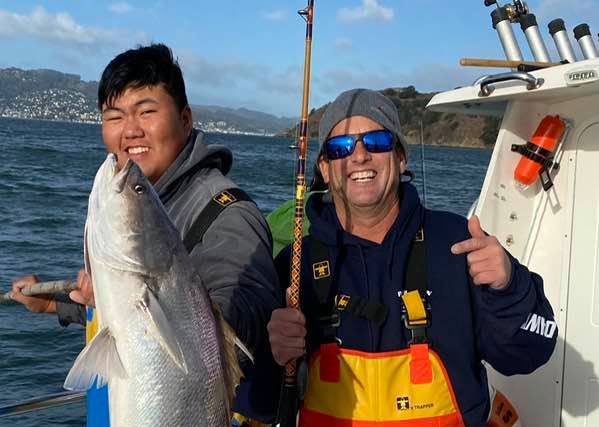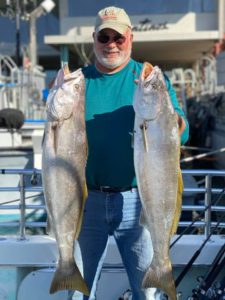
BY DAVE HURLEY
Halloween was on October 31 with ‘Dia De Los Muertos’ on November 1 so it is fitting that we went out during the first week of November in search of apparitions in San Francisco Bay with Captain Ron Koyasako of Nautilus Excursions out of Fishermen’s Wharf. These aren’t frightening phantasms or spirits but the white seabass which are one of the most elusive of all northern California species.
I was introduced to Koyasako this summer through Captain Trent Slate of Bite Charters out of Loch Lomond Marina as Slate was singing the praises of Ron’s ability to seek out the white seabass. Having never landed or even attempted to target a white seabass, they were always on my bucket list of species, but I never actually envisioned having the opportunity to land one of the shy fish. This all changed on Friday, November 6.
Few species raise the interest level of Northern California saltwater fishermen as white seabass aren’t called ghosts because they are easy to locate and catch. They are the largest member of the croaker family, and there has been a commercial and recreational fishery for the species since the 1890s. The fishery has traditionally been associated with Southern California, but in recent years, more and more white seabass have been taken in Monterey, Half Moon Bay, and in San Francisco Bay.
Not only do the fish require quiet in order to entice, the fishermen who target them are even quieter, and normally, you will find out about an outbreak of the action after the fish have moved on. The action normally occurs in a small area around the size of a football field, and boats rushing in can easily put down the bite or cause a number of fish to be broken off on anchor or others’ fishing lines.
Koyasako is a veteran of over 35 years on San Francisco party boats, and he is an astute student of all saltwater species, but he has developed the reputation as ‘The Ghost Whisperer’ for his success at white seabass.
The seabass can be found in both the shallows of the South Bay or the deeper water in the Central Bay, and on this day we headed into the Central Bay to locate the schools in deeper water. After leaving at dark in a howling wind, Koyasako used his electronics to find a massive school before setting anchor. Most boats have been drifting over the schools, but similar to techniques used in Southern California, Koyasako prefers to anchor on the school. Even if you are sitting on fish, they may not bite, and this was the case in the early morning with our crew loading up with Bolinas rockfish in preparation for the big show to arrive later in the day.
Joining me on this adventure was Slate, Matt Smart of Martinez, Johnny Wang of Stockton, and deckhands Andrew Beard and Hunter Nguyen.

Wang and Koyasako go back over 30 years as deckhands on the original Nautilus 1 and Nautilus 2, and they are currently readying the big party boat, the Ultra, for local and long-range trips out of Emeryville. Wang, like myself, is a native of Stockton, and we found many common threads in our upbringing.
Once the fish are located, it is a matter of setting down an anchovy on a live bait rig with the leader composed of 20- to 25-pound fluorocarbon. Most ‘ghost hunters’ use live or fresh-dead squid for the seabass, but inside the bay, the bass are feeding on a combination of anchovies and ghost shrimp. Koyasako said, “If we dropped down to 15-pound fluorocarbon, we would hook a higher ratio of fish, but the light line makes it very difficult to bring them to the gaff as they have extremely sharp teeth and a very hard gill plate.
After going through a number of anchovies on the small rockfish, the main attraction finally arrived once the tide was moving. Koyasako had made several moves, resetting the anchor each time, and he said, “Get ready, there is a school 35 feet thick coming through.” Just as the words came out of his mouth, Beard and Nguyen hooked up on the starboard side with Slate on the hook at the transom. Teamwork is essential as the sea bass pull hard and will run you around the boat.
Since they seem to all go on the bite at the same time, it is a matter of keeping the remaining rods in the water while working together to go over and under while following your fish. Nguyen handed off the rod to me, saying, “All I am interested in is gaffing the fish.” After a bit of a dance and many long runs, I was able to bring my first sea bass to the gaff. We landed all three on that flurry, and we picked at them for a bit with Slate and Beard striking again with their second fish until the tide went slack.
During the slack tide, not even the Bolinas cod were willing to bite. Koyasko made a few more moves, and finally the incoming tide started to push current back into the bay. It was time for the sequel of the early pandemonium to begin, and it started similar to the first round with Koyasako saying once again, “Get ready, there are fish all over the place.” This time my rod went off, and the fish decided to make a run around the bow. As my nimblest days have vacated long ago, Nguyen hopped on the bow and brought the fish around to the starboard side for me to pick up where we left off. While I was concentrating on getting this bass to the boat in spite of its efforts to keep running, the other rods were going off.
Patience is one key to success in the seabass game, and even an experienced captain such as Slate said, “I was so impressed with your ability to stick with the game plan as I would have abandoned this long ago with the lulls in the action.” Within the past three years, Koyasako has close to perfected his techniques after the seabass made a reappearance in the bay. He said, “The fish we caught today were less than the 28-inch minimum a few years ago, and although I have been studying their habits, there is so much I have yet to learn.”
He has learned quite a bit as he has put his clients onto as many as 18 seabass on recent trips, and we decided to call it an early day with 10 bass to 30 pounds in the box along with several other missed opportunities. The white seabass fishery in the bay can be overexploited by commercial fishing, and there have been reports of over 100 fish taken in a single day by the small commercial boats. Similar to white sturgeon and the big six- and seven-gill sharks in the bay, as more and more fishermen figure out how to increase their chances, there is a danger of excessive pressure on the species.
It was a spectacular day targeting a species I had only dreamed about, and the opportunity to bring three to the gaff is now one of the highlights that will stay in my memory bank.
Although his reputation as the ‘Ghost Whisperer’ is well-deserved, Koyasako also specializes in salmon, halibut, striped bass, leopard shark, and sturgeon in the bay out of Pier 45 in San Francisco. He can be reached at www.nautilusexcursions.com or 916-704-4169. Once the Ultra is cleared for action out of Emeryville, Captain Ron will be also working this large party boat for crab combinations with a specialty on long-range albacore trips. Captain Trent Slate of Bite Me Charters out of Loch Lomond Marina in San Rafael is available at www.bitemecharters.net or 415-307-8582.


